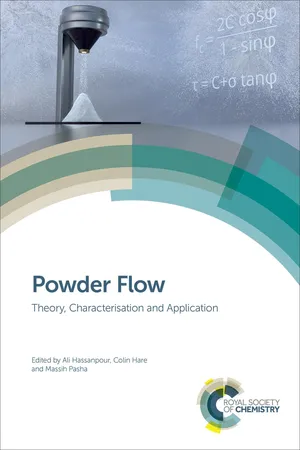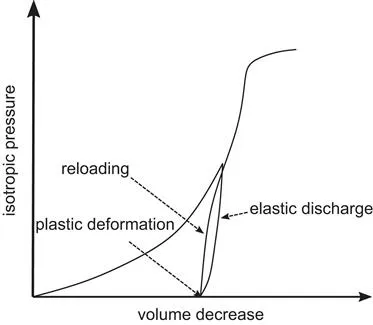![]()
CHAPTER 1
Introduction
A. HASSANPOUR*a AND C. HAREb
a School of Chemical and Process Engineering, University of Leeds, Leeds, LS2 9JT, UK
b Department of Chemical and Process Engineering, University of Surrey, Guildford, GU2 7XH, UK
Powders contain a collection of individual small particles, surrounded by a fluid medium, which is usually air. They can be found in nature or manufactured via different routes such as crystallisation, spray drying and freeze drying of solutions or slurries, and crushing and grinding of larger solids. Powders are encountered in food, healthcare, homecare, cosmetics, hygiene, biotechnology, energy, mining, fine chemicals, and high value additive manufacturing sectors. Overall, more than half of globally manufactured products in the above sectors are in the form of particulate solids or powders,1 hence their impact on the world economy is significant.
Powders have heterogeneous attributes in terms of differences in particle size, shape, and mechanical and analytical properties, hence predicting their collective behaviours is extremely challenging. Interestingly, bulk powders could potentially exhibit behaviour akin to all three forms of matter.1 Under certain packing conditions and applied stresses powders can start to flow like fluids; this property is commonly termed “flowability”. Once powders are compressed, they can behave like a gas, where the “bulk volume” can reduce under the applied stress, leading to closer particle packing and interaction; this attribute is known as “compressibility”. Under certain environmental conditions and (higher) compression stresses, powders with specific individual properties can form dense strong compacts and behave like solids; such a property is known as “compactability”.
Unlike fluids and continuum solids, where the properties of known compounds can be predicted or found summarised in the literature, the three aforementioned powder properties cannot easily be predicted or presented by unique values, as they are affected by the inherent physical, mechanical and analytical properties of individual particles in the particular powder sample, the environmental conditions, the level of applied stresses and the packing state (powder history). Flow of bulk powders is for instance a key behaviour that is encountered during various handling and processing steps in different sectors. Hence, extensive attention has to be paid to characterise such behaviour and determine the ‘flowability’ of different powdered compounds.
Our knowledge and understanding of fluid mechanics and dynamics, achieved during undergraduate studies in chemical, process and related engineering disciplines, is usually sufficient to meet the needs of the relevant industry, while in most disciplines we do not adequately cover powder mechanics topics. This shortcoming often leads us to implement the fluid analogy in powder flow behaviour, where the degree of heterogeneity in properties and history of powders and the influence of environment are usually overlooked. This could be quite critical for formulated powders, where the level of non-uniformity and the consequent uncertainty in predicting their flow behaviour escalate to a much higher degree. The impact of such ambiguity could be very significant on the relevant industry, particularly in presenting challenges for the route to commercialisation of novel products from the early stage development, which requires design of necessary processes, scale up and their optimisation to ensure the final product quality.2 Hence, a need for training in this area, and gaining an understanding of powder flow theory, its characterisation and how it can be applied in real processes is highly desirable for our engineers, graduates and students in the chemical, process and relevant engineering disciplines. This book aims to address such needs by presenting the following chapters.
Chapter 2 presents a summary of flow related properties of bulk particulate systems, the ways in which assemblies of powder can be characterised, and fundamental properties that can be measured. In particular, concepts such as macroscopic response of bulk powders to stress and their yielding, and the role of individual particle properties are discussed. Prevailing conditions leading to powder flow, in terms of the stresses and their estimation in different conditions, including how this varies and is compared to stress in a liquid, is discussed in Chapter 3. Furthermore, the influence of strain rate on different flow regimes as well as effects of time consolidation and environmental conditions are presented here. Chapter 4 presents a comprehensive review of state-of-the-art techniques for characterisation of powder flow properties. Different categories relevant to the state of powders (history) are discussed and available commercial and in-house developed devices are presented. Modelling methods to correlate bulk flow behaviour with the individual particle properties are reviewed in Chapter 5. Both continuum and discrete approaches are discussed with reference to a number of case studies relevant to powder flow. Chapter 6 explores a number of common powder processing problems that may be faced by industry and presents methods to apply powder flow characterisation in order to predict powder behaviour in representative handling and processes steps. The correlation between measured properties and powder behaviour during discharge, die filling and tabletting processes are discussed. Finally, overall concluding remarks and future directions for powder flow characterisation and applications are summarised in Chapter 7.
References
1. M. Rhodes, Introduction to Particle Technology, John Wiley & Sons Ltd., Chichester, 2nd edn, 2008.
2. T. A. Bell, Powder Technol., 2005, 150, 60–71.
![]()
CHAPTER 2
Flow Related Properties of Bulk Particulate Systems
A. DE RYCK*a AND C. HAREb
a IMT Mines Albi, Université de Toulouse, Centre RAPSODEE UMR CNRS 5302, Route de Teillet, Albi F-81000, France
b Department of Chemical and Process Engineering, The University of Surrey, Guildford, GU2 7XH, UK
2.1 Introduction
This chapter gives the basics and more pertinent mechanical descriptors for bulk particulate systems, and introductory information on how to measure them (full descriptions of powder flowability characterisation techniques are given in Chapter 4). Another contribution of this chapter is to explain how these descriptors of the macroscopic mechanical behaviour emerge from the particles and particulate system properties. The collective mechanical response is induced by the forces acting and their spatial distribution. The forces are the weight of the particles, interaction with the ambient gas or surrounding liquid, and forces at contact points between particles. Their geometrical distribution comes from the packing of the particles, their sizes and morphologies. By relating these properties, we are able to infer the major properties influencing the flowability of a bulk material. If we consider these properties, a qualitative evaluation of the flowability may be performed.
The chapter begins with the macroscopic mechanical response of a granular media under stress, the packing fraction, yielding and an introduction to the key concepts of bulk friction and cohesion for the bulk solid. The mechanical response is then formalised by the yield loci and flow-function. To complete this bulk description, the mechanical behaviour of the particulate solid at the vicinity of the walls is provided and illustrated by storage or mixing situations, where the bulk solid–wall interactions have a huge influence on the flow behaviour.
This chapter then studies the collective fluid–particle interactions in the case of fluidisation phenomena. The final sections are dedicated to the individual particle properties influencing these collective behaviours, such as the particle size and shape, and their distributions, explaining the origin and properties of the forces leading to cohesion.
2.2 Compressibility Response
In the general case of a randomly distributed particulate system, the solid particles occupy only a fraction of the space. Some voids remain between the particles since they do not occupy all of the space, due to their shape and spatial position. The fraction that is free space, ε, is called the porosity, and the remaining volume occupied by the solids, χ=1−ε, is named the solid fraction. When submitted to an isotropic pressure, an initial packing generally contracts, firstly by irreversible rearrangements, as particles pack more tightly. This can be checked by unloading, where irreversible rearrangements do not allow the initial volume to recover1,2 (see Figure 2.1). At higher pressure, the specific volume is maintained, with only a low elastic deformation when the inter-particle forces are able to sustain the external isotropic pressure. Finally, at high pressure, large plastic deformation and/or crushing of the solid particles occurs, thus leading to a wider size distribution and tighter packing, and therefore resulting in a volume decrease.
Figure 2.1 Sketch of pressure–deformation curve in isotropic compression, with one intermediate unloading point revealing an irreversible deformation.
Focusing on the initial rearrangement phase, the compressibility response depends on the initial state, which may be more or less loose, depending on the material properties and the forces present. Two generic situations, largely encountered in process engineering, are now described in more detail.
2.2.1 Large Particles or Sand-like Bulk Solids
The pouring of sand-like or large particles leads to an initial state that is close to the maximal packing since the weight of the particles is sufficient enough to drive them to this configuration. Therefore, a low compressibility is obtained when exerting an isotropic pressure on a ...

